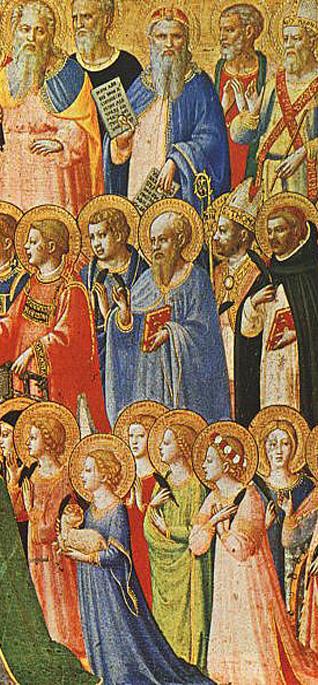Columnists
When Saints Go Marching In
by MANJYOT KAUR & I.J. SINGH
"When the saints go marching in ..." says a popular Christian hymn, most often heard nowadays as a quintessential Dixieland jazz tune.
But how does one define a saint? What makes a saint? And why be one even if you can?
We know that Roman Catholics have a finely honed, infinitely nuanced mechanism for making one - the long, drawn-out process of canonization, as it is called. It has been used only since the 10th century; for hundreds of years prior, starting with the first martyrs of the early Church, saints were chosen by public acclaim.
The rules of the Vatican, which underwent sweeping changes in 1983 by Pope John Paul II, require that a candidate has to be dead at least five years before the process is initiated and there are a minimum of two credible, verifiable miracles (one for beatification and one for canonization) attributed to the person. (However, in the case of a martyr, a miracle is not required for beatification.) And there is the inexhaustible amount of paperwork on the details of the person's life.
Sometimes, the progression can be accelerated. For instance, Mother Teresa died in 1997; the Pope allowed the process to start early. She was beatified in 2003; canonization to sainthood awaits the confirmation of the second miracle.
Our purpose today is not to dissect the Roman Catholic tradition, but to let this explanation of it lead us into a consideration of the idea in Sikh doctrine, teaching and practice.
Clearly the English word "saint" and the Punjabi appellation "sant" are more than kissing cousins. Their linguistic roots may not be entirely identical, however.
"Saint" is derived from the Latin sanctus (holy, consecrated) and sancire (to consecrate). Originally an adjective prefixed to the name of a canonized person, by 1300 or thereabouts, it came to be regarded as a noun.
"Sant" may be a modified form of sat which can simply mean "true," but can also be translated as "lasting," "real," and "venerable." Sat - or satya - has commonly been used since Vedic times to represent the Ever-existent Unchanging Reality, or the Self-existent Universal Spirit, that is, Brahma or God. When parsing roots of words, keep in mind that Sanskrit may be the root of the linguistic tree that gave us the Romance languages, which sprang from Latin.
The term sant itself came into vogue later, occurring in the ancient Pali literature of Buddhism in the sense of "tranquil," "true" or "wise." From Pali, it resurfaced centuries later when the Bhakti movement, with its distinct Sant tradition, arose. The Sant-Bhaktas were opposed to Brahmanical ritualism, idol-worship and casteism. They valued a "love relationship" between an individual and the Unborn, Formless, Nirguna Divine entity. Through the Bhakti movement, the term passed into the Sikh tradition.
Unlike the English term, which has a formal connotation in a Western religious framework, "sant" is not always used in a formal way, but in a more subjective sense. To the average person today, it might convey the idea of a person possessing immense sagacity and judiciousness, with a profound understanding of Dharam.
Turning to our people - the Sikhs: There is no orderly process, and there has never been one, for ordaining a sant. It is true that during the Guru period - a little over 230 years - and the subsequent 100 years, there is no mention of anyone, not a single person, who was revered as or addressed as "sant" in the Sikh tradition.
But the concept of what a sant is, or what saintly virtues are, is central to the understanding of Sikh spirituality. Gurbani provides a strong, unmistakable sense of what a saintly life entails - and it does not involve the working of miracles.
Let's explore what history, tradition, and gurbani tell us about sants and saintliness.
In the attributes of martyrs and confessors who have been canonized, the Roman Catholic Church speaks of "confessing Jesus in the presence of enemies." It would seem that, by this criterion alone, reinterpreted in the context of Sikhi, our history can provide an almost endless supply of sants - Bhai Taru Singh, Sati Das, Mati Das, Banda Singh Bahadar and Baba Deep Singh would be heading quite a lengthy list.
One among the myriad of definitions of "sant" that gurbani provides us with is:
"Jinaa saas giraas na visrai har namaan man mant/ dhann se sayee naankaa pooran soee sant" [GGS, M5:319:18]
("They who do not forget the Lord, with each breath and morsel of food, whose minds are filled with the mantra of the Lord's Name/ They alone are blessed, O Nanak, they are the perfect saints.")
Guru Arjan goes on to explain:
Ayk naam santan aadhaar/ Hoay rahay sabh kee pag chhaar
Sant rahat sunhu mayray bhaaee/ Uaa kee mahimaa kathan na jaaee (Rahaao)
Vartan jaa kai kayval naam/ Anad roop keertan bisraam
Mitar satar jaa kai ayk samaanai/ Parabh apunay bin avar na jaanai
Kot kot agh katanhaaraa/ Dukh door karan keea kay daataaraa
Soorbeer bachan kay balee/ Kaulaa bapuree santee chhalee
Taa kaa sang baachheh surdayv/ Amogh daras safal jaa kee sayv
Kar jorh naanak karay ardaas/ Mohi santeh tahal deejai guntaas.
[GGS, M5:392:13]
("The One Name is the support of the saints; they remain the dust of the feet of all.
Listen to the way of life of the saints, O my siblings of destiny;
Their praises cannot be described. (Pause)
Their occupation is the Naam, the Name of the Lord.
The kirtan, the praise of the Lord, the embodiment of bliss, is their rest.
Friends and enemies are one and the same to them.
They know of no other than God. They erase millions upon millions of sins.
They dispel suffering; they are givers of the life of the soul.
They are so brave; they are men of their word.
The Saints have enticed maya herself.
Their company is cherished even by the gods and the angels.
Blessed is their darshan, and fruitful is their service.
With his palms pressed together, Nanak offers his prayer:
O Lord, Treasure of Excellence, please bless me with the service of the Saints.")
Indeed, one could cite hundreds of pages of gurbani regarding the importance of the sant, and by extension, sadh sangat. The words "sant" and "sadh" (as well as the related "jan") appear with extreme frequency in Guru Granth - on virtually every page.
For example, in the bani of Sukhmani Sahib, three complete ashtpadis (octets) are devoted to this topic alone. Insights into the concept of sant and, more importantly, its application, are vital to our understanding of gurmat.
While we all have a need to respect and revere gursikhs as our role models, it is anathema to consider a living individual as a sant or guru, when our Gurus have made it clear that only the Shabad, and no human being, is to be so regarded. We must beware of people who attempt to create fragmentation in and deviations away from the mainstream panth, those who promote a so-called "sant," or a particular "dera" or "jatha" as genuine.
Fortunately, gurbani teaches us to submit only to Guru Granth as the spiritual form of the Guru, and Guru Panth as the physical form.
Still, gurbani stresses the company of a sant as being indispensable. So how, then, do we find one?
We are to seek the company of a sant in the sadh sangat, not in a particular individual who claims to be a sant, and demands our fealty and worship. A sant would never make public assertions of visions, spiritual experiences, supernatural powers, etc. Just as one lamp lights another, we must have a burning desire to be uplifted towards inner perfection through the company of gursikhs, our sadh sangat.
Gurbani is saturated with shabads expressing the desire to meet a perfect gursikh. For example:
Jo deesai gursikhrhaa tis niv niv laagao paa-ay jeeo
Aakhaa birthaa jeea kee gur sajan deh milaa-ay jeeo
Soee das updaysrhaa mayraa man anat na kaahoo jaa-ay jeeo
Ih man tai koon dayvsaa mai maarag dayh bataa-ay jeeo.
[GGS, M5:763:1]
("When I see a Sikh of the Guru, I humbly bow and fall at his feet.
I tell to him the pain of my soul, and beg him to unite me with the Guru, my Best Friend.
I ask that he impart to me such an understanding, that my mind will not go wandering anywhere else.
I dedicate this mind to you. Please show me the Path to God.")
When we are in the company of genuine sadh sangat, with our egos silenced through the awesome power of kirtan, gurbani comes alive for us, taking on new and potent meaning, proof that we may truly become God-conscious, emancipated and liberated while living in this world.
Jio chandan nikat vasai hirad bapurhaa tio satsangat mil patit parvaan. [GGS, M4:861:8]
("The poor castor oil plant, growing near the sandalwood tree, becomes fragrant; in the same way, the sinner, associating with the saints, becomes acceptable and approved.")
We don't quite know when the first "saint" emerged on the scene in Sikh culture, but it is an undeniable fact that they have now proliferated more profusely than mushrooms; the countryside of Punjab is lush with them.
They are indeed a dime a dozen in Punjab. They will show you God, they say. They guarantee you a place in heaven. They will grant your every wish, they promise. What is asked of you in return? Only your worldly possessions, lifelong devotion, service and fealty.
Why are so many self-proclaimed saints finding fertile ground in Punjab today? The answer may lie in the often desperate quality of life and precarious sense of existence, particularly since 1984, as well as the increasing disconnect from the language, content and meaning of the message of Sikhi. When the future seems closed with no light at the end of the tunnel, those who purport to be clairvoyant frequently appear to be the only hope.
The politico-religious leaders in Punjab today have lost the idea of why they exist. The bureaucracy - civil servants - seem to have never learned the meaning of "civil" or "servant."
Ambrose Bierce, in his 1911 Devil's Dictionary, defined "saint" as "a dead sinner, revised and edited." So perhaps Oscar Wilde was right when he claimed that "Every saint has a past and every sinner has a future."
[Gurbani translations, courtesy of Dr. Sant Singh Khalsa]
manjyot818@gmail.com
March 19, 2010
Conversation about this article
1: Sangat Singh (Kuala Lumpur, Malaysia), March 19, 2010, 5:30 PM.
Thw whole article is succinctly encapsulated in the following lines: "Ambrose Bierce, in his 1911 Devil's Dictionary, defined 'saint' as 'a dead sinner, revised and edited.' So perhaps Oscar Wilde was right when he claimed that "Every saint has a past and every sinner has a future." Bhoomiya, Sajjan Thug, Noor Shah, Kauda Raakash and Bidhi Chand are recalled, among many others, to give credence to the above lines. It is never too late to become a 'sant' and some of the babas do take this hint quite seriously. 'Mai sabh kichh chhod prabh tuhee dhia-aa-aa". [GGS:371]
2: Kanwal Nain Singh (Lindsay, Ontario, Canada), March 20, 2010, 10:43 AM.
Great article indeed. Now what bothers me is that the mushrooming institutions like 'akhaaras','jathas', and 'deras' headed by the self-annointed sants in Punjab, are experiencing an uncontrolled growth in the community, more so in the last few decades. How can this blind following be eradicated from the community? Is it the responsibility of the S.G.P.C., or the sangat itself? It is nothing short of decay and smacks of brahmanism.
3: Ravinder Singh Taneja (Westerville, Ohio, U.S.A.), March 20, 2010, 9:53 PM.
As far as I know, the word sant has been used for the Guru (Guru person), God and GurSikhs (plural). Sant is also a state of mind. The presence of counterfeits should not lead us to believe that the genuine article does not exist. I do believe that we have become paranoid about acknowledging the role, influence and spiritual mentoring that individual Sikhs can (and do) provide - for fear that we may be seen as sant/ baba followers. Even in sangat (as in more secular associations), there is usually an individual that stands out and becomes (de facto) the guide for many because of experience. We don't think twice about having coaches and guides in other fields; what makes us think that spiritual growth can happen without such guidance. It cannot. Now, we may end up calling the individual a "sant" out of respect, even though it would be an inappropriate use of the term.






